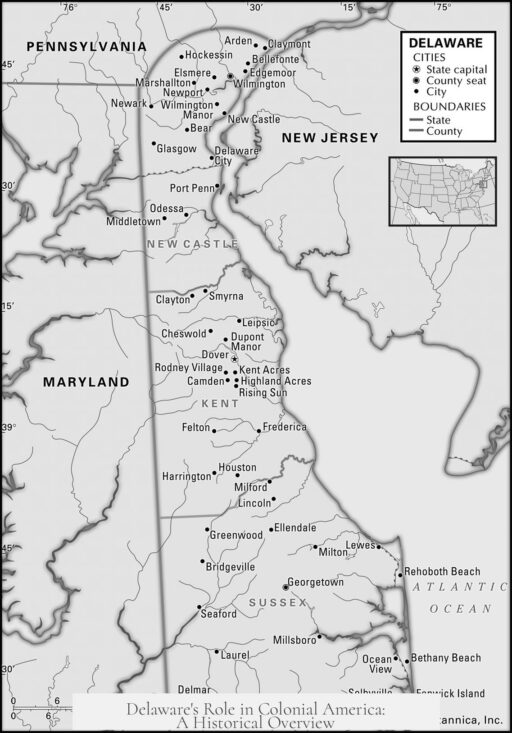Delaware was considered a colony but never a fully independent English colony like others; it functioned largely as a subsidiary or dependent jurisdiction under various proprietary and colonial controls.
Initially, Delaware was not an English colony but was subject to Dutch and Swedish colonial efforts. Around 1631, the Dutch briefly established a presence, which soon disappeared. Then the Swedes founded New Christiana along the Delaware River, creating the first sustained European settlement. The Dutch reclaimed the territory around 1655, incorporating it into New Netherland.
After the Second Anglo-Dutch War, England seized control of the area in 1674. Subsequently, the territory fell under the Duke of York’s grant, linking it to New York’s colonial administration. Despite this attachment, Delaware was managed separately from New York, reflecting its distinct identity and administration.
During this period, Delaware experienced overlapping territorial claims, especially after 1681. Both Maryland and Pennsylvania laid competing claims on parts of the region. Residents occasionally faced threats from tax collectors representing both colonies. These contested claims complicated governance and underscored Delaware’s transitional status.
The more defining relationship for Delaware commenced in 1682 when William Penn received a grant including lands west of Delaware Bay. Penn’s acquisition formed the foundation for Pennsylvania and the so-called “Lower Counties” on the Delaware Bay (modern Delaware). Penn attempted to unify his diverse settlers into a collective polity but faced substantial challenges.
The population north of New Castle mainly consisted of English Quakers arriving with Penn, while the southern counties had Swedish, Finnish Lutherans, Dutch Calvinists, and English Anglicans. Differences in religion, culture, and previous settlement history caused persistent tensions.
- Disputes erupted over governance, tax collection, and political representation.
- Pacifism of the Quaker leadership clashed with southern counties’ desire for local defense funds.
- Residents found themselves caught between distinct governance styles and priorities.
These tensions produced a constitutional response. In 1701, Penn was compelled to issue a new charter allowing Delaware’s “Lower Counties” to form a separate legislative assembly. By 1704, Pennsylvania and Delaware operated distinct legislative bodies. Delaware’s government included its own militia and local courts, even though the colonial upper courts served both regions in circuit.
Though Delaware developed a separate assembly and legal framework, it remained effectively subordinate to Pennsylvania’s proprietary governance. It did not have an independent colonial charter from the Crown. Instead, it was a subsidiary entity sharing a complex relationship with its larger neighbor.
The question of whether Delaware was a “colony” hinges on definitions. Delaware functioned with many hallmarks of a colony: its own legislative assembly, local courts, militia, laws, and administrative identity. These separate institutions qualified it as a colony in practice, even without a distinct royal charter.
In 1776, Delaware took a decisive step towards full independence, declaring separation from both Pennsylvania’s control and the British Crown. This secession predated the Continental Congress’s Declaration of Independence. It emphasized Delaware’s drive to assert sovereign status, distinct from proprietary and royal authorities it had experienced for decades.
| Period | Status of Delaware | Remarks |
|---|---|---|
| 1630s–1655 | Dutch and Swedish settlements | Early foreign colonies, New Christiana established |
| 1655–1674 | Dutch control via New Netherland | Territory administered by Dutch authorities |
| 1674–1681 | English annexation, attached to Duke of York’s grant | Administered separately, overlapping claims begin |
| 1682–1704 | Part of Pennsylvania Proprietary Colony (Lower Counties) | Separate representation issues emerge |
| 1704–1776 | Delaware operates semi-autonomously with separate assembly | Subsidiary colony under Pennsylvania proprietary rule |
| 1776 onward | Independent state | Declared independence from Crown and Pennsylvania |
Delaware’s colonial identity is complex. It was not a fully independent colony with its own royal charter during most of its colonial history. Instead, it remained administered as part of other colonial frameworks but maintained significant institutional autonomy, especially from 1704 onward. This balance of subordination and self-rule distinguishes it from more straightforward examples of colonies.
- Delaware began as Dutch and Swedish colonies before English control.
- It was attached to the Duke of York’s grant and not a stand-alone colony initially.
- William Penn acquired Delaware, governing it as part of Pennsylvania but with separate assemblies.
- Ethnic and religious diversity caused disputes dividing Delaware’s upper and lower counties.
- Delaware gained a semi-autonomous legislature in 1704 but lacked a distinct royal charter.
- It declared independence in 1776 before breaking from both Pennsylvania and Britain.
- Delaware qualifies as a colony by having separate laws and assemblies but not fully independent until statehood.




